
Text © Prof. Pietro Pavone

English translation by Mario Beltramini
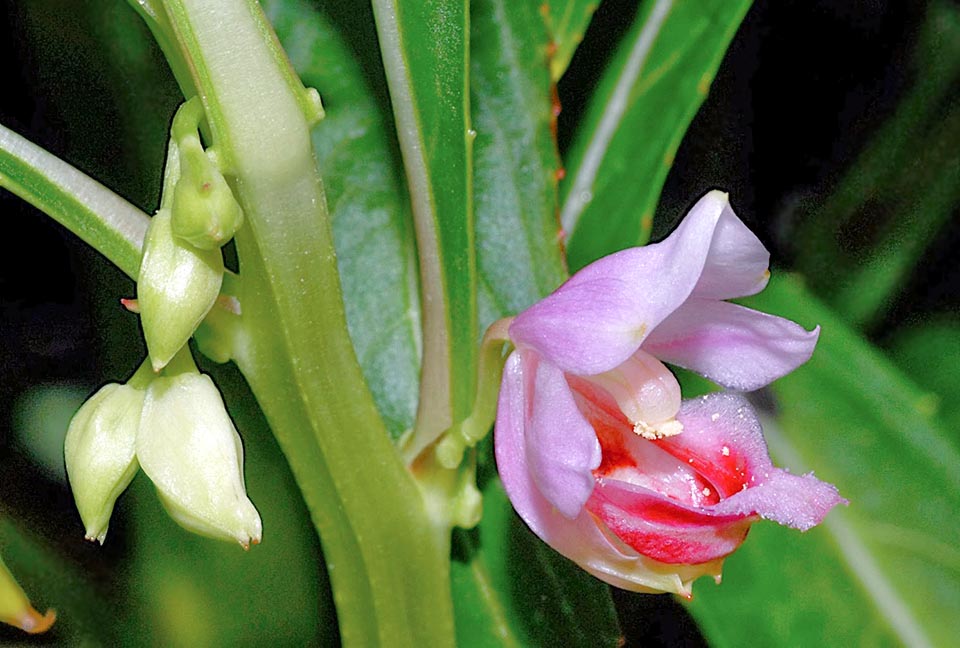
The Balsaminaceae family count only two genera: the Impatiens, with more than 1000 species, and the Hydrocera, with only one species, the Hydrocera triflora shown here. Native to India and South East Asia grows feet in the water, in slow courses such as ponds, rice fields and pools, where forms even one-metre-high tufts © Robert Combes
The family Balsaminaceae A.Rich. (1822) gets its name from Balsamina, common name of Impatiens balsamina L. that in turn comes from the Greek “βάλσαμον”, balsam (bálsamon) because it produces substances having a strong aromatic smell.
It is a family of Dicotyledonous plants recently inscribed in the order Ericales by the system of botanical classification “Angiosperm Phylogeny Group” of 2016 (APG IV).
The family includes only two genera: Hydrocera with the only species Hydrocera triflora (L.) Wight & Arn. and Impatiens with more than 1000 species.
They are annual or perennial herbs, at times with tubers or rhizomes, occasionally shrubs or epiphyte, with erect or procumbent stems, usually succulent, rarely woody at the base, often rooting in the lowest nodes. The suffruticose species can reach 4 m of height, whilst the herbaceous ones have a height varying from 20 to 80 cm depending on the species.
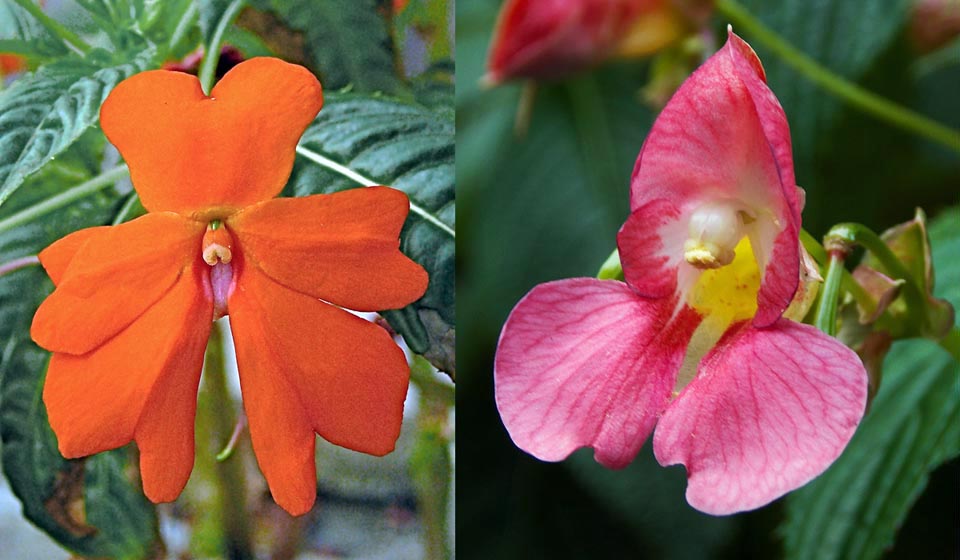
Impatiens platypetala and Impatiens rothii. Whilst in Hydrocera petals are free, in Impatiens the lateral petals are united in pairs at the base © Robert Combes (left) and © Buzz Clark (right)
The leaves are simple, alternate, opposite of verticillate, pedunculate or sessile, without stipules or sometimes with stipular glands at the base of the petiole, with pinnate veins, crenate, toothed or serrated margins.
The flowers are solitary or merged in axillary racemose inflorescences, zygomorphic, usually resupinate of 180°, that means rotated in respect to their initial position as it occurs in almost all flowers of the family Orchidaceae.
The calyx is formed by 3 or 5 free petaloid sepals. The lowest one (due to resupination) is bigger, navicular to funnel shaped, saccate usually thinned in a nectariferous spur. The corolla is formed by five petals, one of them, the upper dorsal, is usually hooded, whilst the others are united in lateral pairs, each one with two unequal lobes ( i.e. Impatiens platypetala Lindl.). Conversely, in Hydrocera, the sepals and petals are free.
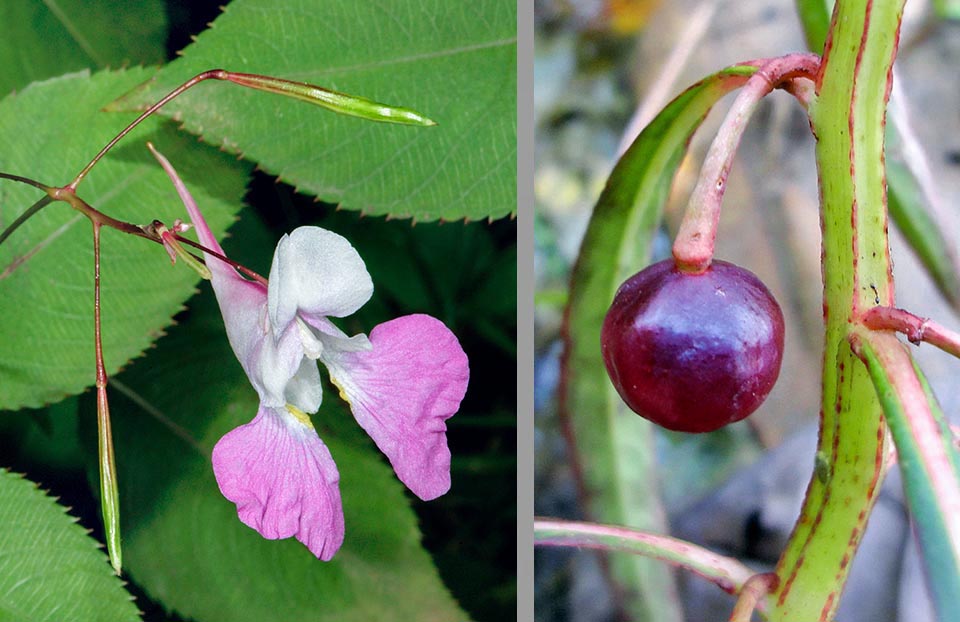
There is disparity in fruits: in Impatiens it is a dehiscent fleshy explosive capsule, whilst in Hydrocera is a fleshy and indehiscent pseudo-berry © Giuseppe Mazza (left) and © Kwan Han (right)
The stamens are 5, alternate with the petals, whose anthers are fused together (connate) in a ring to form a sort of cap that wraps the ovary and the stigma, and detach, in one single piece, before that the stigma ripes, thus ensuring the crossed fecundation.
In some species (Impatiens inaperta H. Perrier) there is the autogamy due to the aborted opening of the perianthium (cleistogamy) that prevents the passage of the pollen. The gynaeceum is syncarpous, with one superior ovary, with 5(4) fused carpels. The placentation is axial, the ovules are anatropous, one per carpel in Hydrocera or many in Impatiens.
In the Balsaminaceae have been observed different pollinators depending on the shape and the colour of the flower. Usually, it has been noted that the flowers with erect dorsal petal or hooded and little deep inferior petal, filiform spur, and pink, mauve, or violet flowers are visited by the butterflies; the flowers with hooded dorsal petal and little deep inferior one, filiform spur, white flower, are visited by the moths.
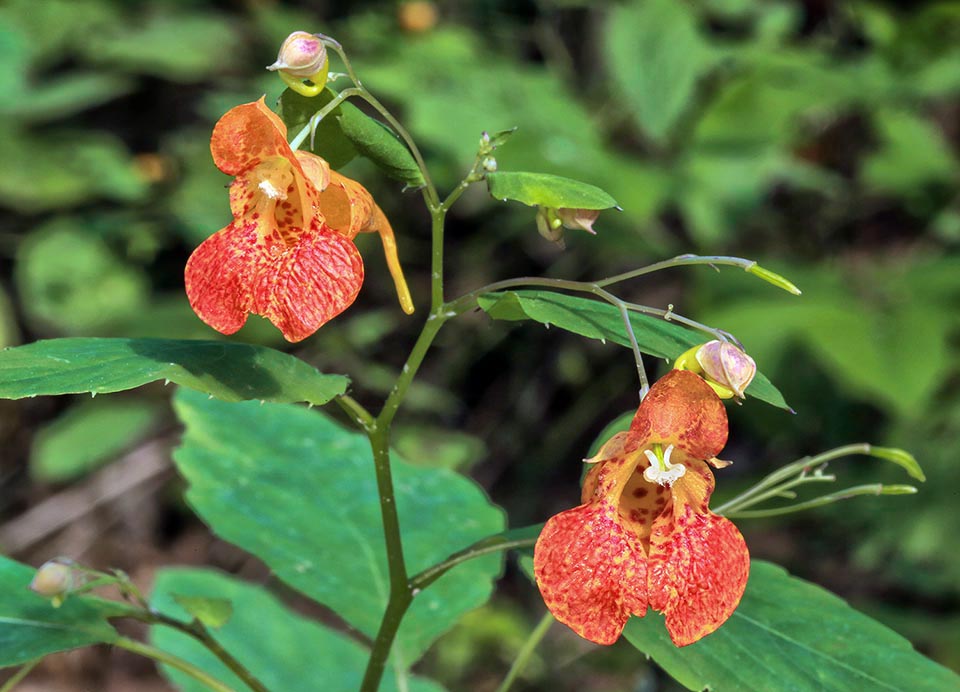
The showy yellow-orange flowers, rich of nectar, of the Impatiens capensis are borne by long flexible peduncles to pollinate repeatedly, oscillating, various pollinators © Alan Cressler
The flowers having hooded dorsal petal, inferior sepal deeply navicular, curved spur and white, yellow or pink flowers are pollinated by the bees; the flowers with hooded dorsal petal, inferior sepal amply saccate, curved spur and pink or mauve flowers are pollinated by solitary bees; the flowers with hooded dorsal petal and inferior external, filiform or curved spur and red flowers are pollinated by birds.
The passage from the regular flower to the zygomorphic and the resupination seem to be strictly associated to the pollinator and this with the aim of obtaining an efficient crossed pollination. The Balsaminaceae may be considered as the Orchidaceae of the Dicotyledons.
Recent studies have proved, however, that also morphologically specialized flowers may attract different visitors. In fact, in the Impatiens burtonii Hook.f. three different pollinators have been observed.
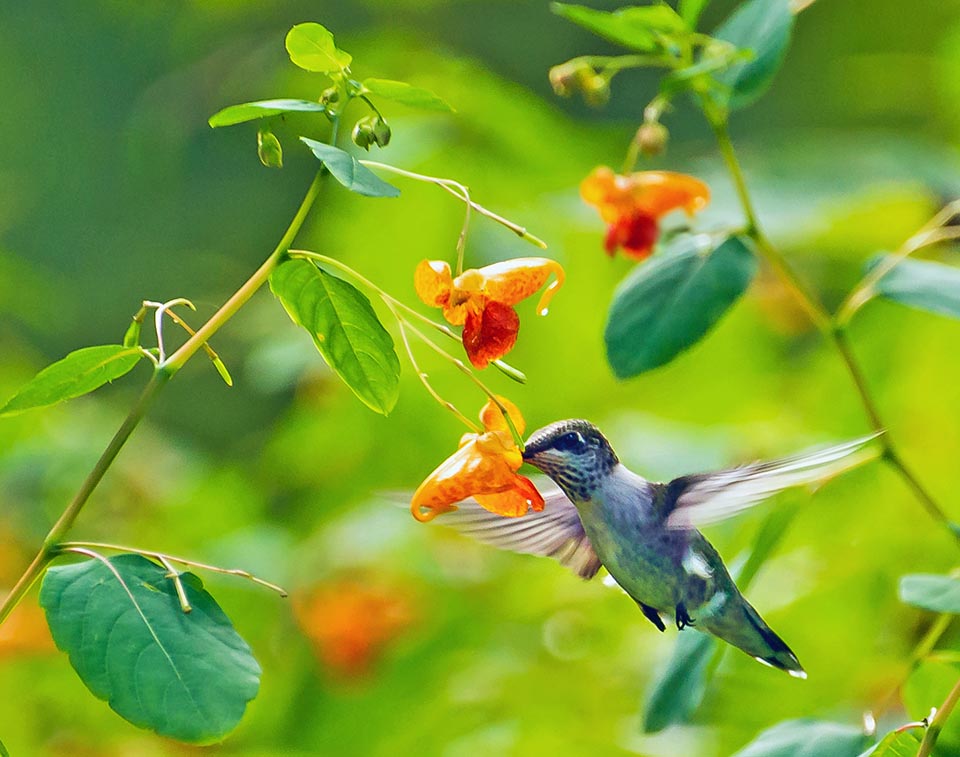
It’s the turn of a hummingbird. Some Balsaminaceae have, on the leaves or on the stems, special glands offering sugary substances to the ants to turn out the intruders © Amy Buxton
The Hoverfly (Melanostoma sp.), that has a short proboscis and nourishes of pollen and nectar close to the entry to the spur; the Syrphid (Rhingia mecyana) that has a long proboscis and the Western hover bee (Apis mellifera).
From the observations done it has been possible to deduce that although R. mecyana has been the only visitor able to reach in depth the spur and that its visits were even more frequent, has not deposited a quantity of pollen granules greater to that of the other two visitors.
In the Balsaminaceae are at times present extrafloral nectars, in the form of stipitate glands, that have the function of attracting the ants to protect the flowers from the possible damages caused by non pollinating animals. The fruit is a bacciform drupe (pseudo-berry) with 5 schizocarpic kernels in Hydrocera or one capsule, rather fleshy, elastically dehiscent, explosive, by means of 5 valves that, if touched, separate rapidly throwing the seeds in Impatiens. The seeds are globose, tuberculate, brown blackish.
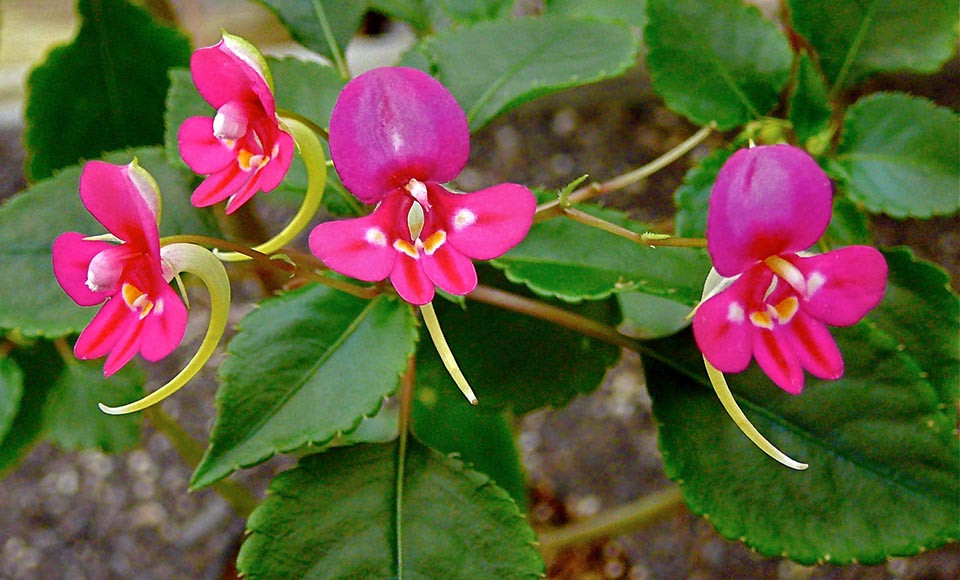
Some species are confined in limited areas, like Impatiens kilimanjari, endemic to the mountain pluvial forest in the Kilimanjaro National Park © Robert Combes
Morphologically, the two genera of the family therefore differ for the following characters: Hydrocera has the petals free and the fruit is a fleshy and indehiscent pseudo-berry; Impatiens has the lateral petals united in pairs and the fruit is an explosive dehiscent fleshy capsule. Hydrocera is limited to India and to south-eastern Asia whilst Impatiens is present in Asia, Africa, Madagascar, India, Europe and North America whilst it is absent in Australia and in South America.
The genus Impatiens is found in the tropical and subtropical mountain forests, often in the humid sites, along the banks of the rivers and of the streams or in the zones close to the waterfalls. Most of the species are terricolous, only a few ones are epiphyte. Many species of Impatiens are confined in rather limited areas such as Impatiens kilimanjari Oliv. found in the mountain rainforest of the National Park of Kilimanjaro (Tanzania); Impatiens denisonii Bedd. growing on the humid rocks and on the trunks of trees at 1000-1600 m of altitude. In the western Ghats in South India; Impatiens bicaudata H. Perrier, typical to Madagascar, having red flowers with domed upper petal, yellow throat and two spurs rich in nectar.
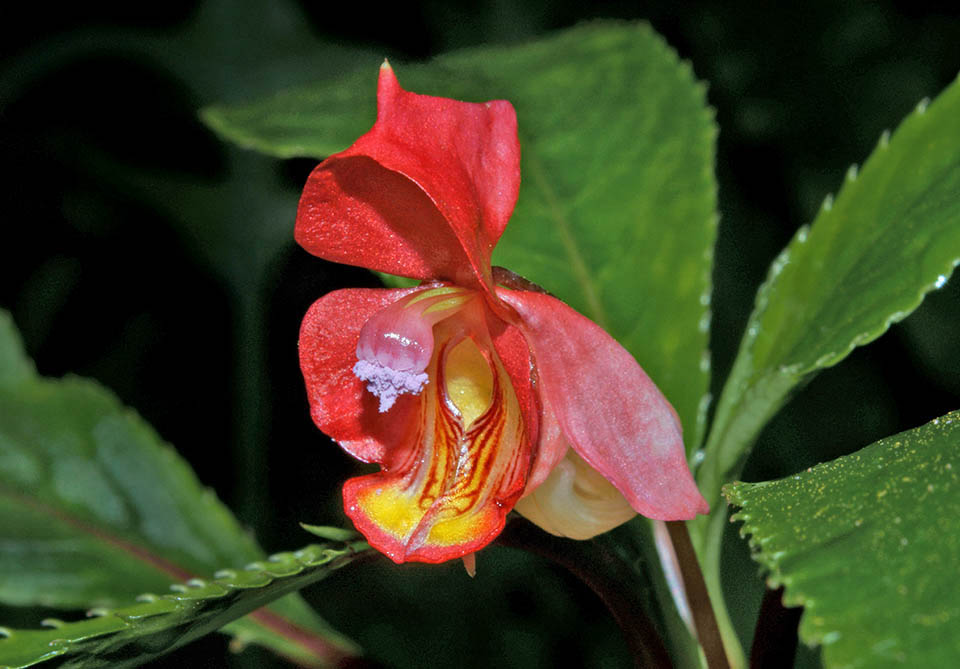
They are usually terricolous plants but there are also epiphytes. The flaming Impatiens bicaudata is typical of Madagascar. It has yellow throat and two spurs rich of nectar © Alan Gregg
The genus Hydrocera is present in the Asian and Indian plains in semi-aquatic environments, such as swamps, humid zones and paddy fields.
Recent studies indicate that inside the genus Impatiens the diversification did probably start in the Paleocene (about 59,3 million of years ago) with an increase of the speciation rate during the last 5 million of years (inferior Pliocene) and it was the climate change to cause the fragmentation and the migration of the ancestral population, with relevant isolation in some areas. Furthermore, it was very likely that the family has been primitively herbaceous and the increase of the size of the stem occurred thanks to the expansion of the medullary cells.
Also the chromosome number of the genera is important because it gives information about the evolution chromosome and cytogeographical of the Balsaminaceae. The chromosome number of Hydrocera triflora is 2n = 16 (n=8), whilst Impatiens has numbers varying from n = 6 (n=6) to 2n to 66 (n=33).
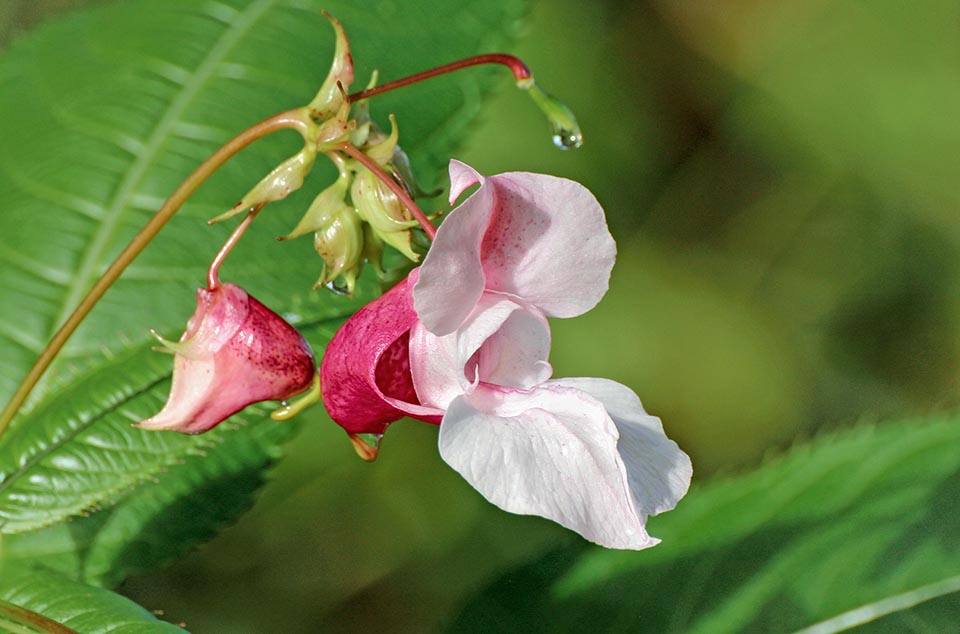
In Pakistan they treat the urinary system disorders, heart diseases, baldness and miscarriage risk with decoctions of Impatiens glandulifera leaves © Ramunė Vakarė
The geographical distribution the most frequent base number is: x = 7 and 8 in Africa; x = 7,8,10 in southern India and in Sri Lanka; x = 7,9,10 in the Himalaya; x = 7,8,9, 10 in SouthEast Asia an x = 10 in northern Asia, Europe and North America.
It is probable, therefore, that x = 8 and x = 9 are the ancestral base numbers confirming the Asian origin of the family.
The economic importance of the Balsaminaceae relies on several utilizations. It is possible to obtain dyes, cosmetics, medicines, edible plants and ornamental cultivars. Many species of Impatiens have been utilized for hair colouring and for nails polishing since ancient times.
In Ethiopia the roots of Impatiens rothii Hook. f., chewn or homogenized in water, are utilized against the infestations by internal parasites.
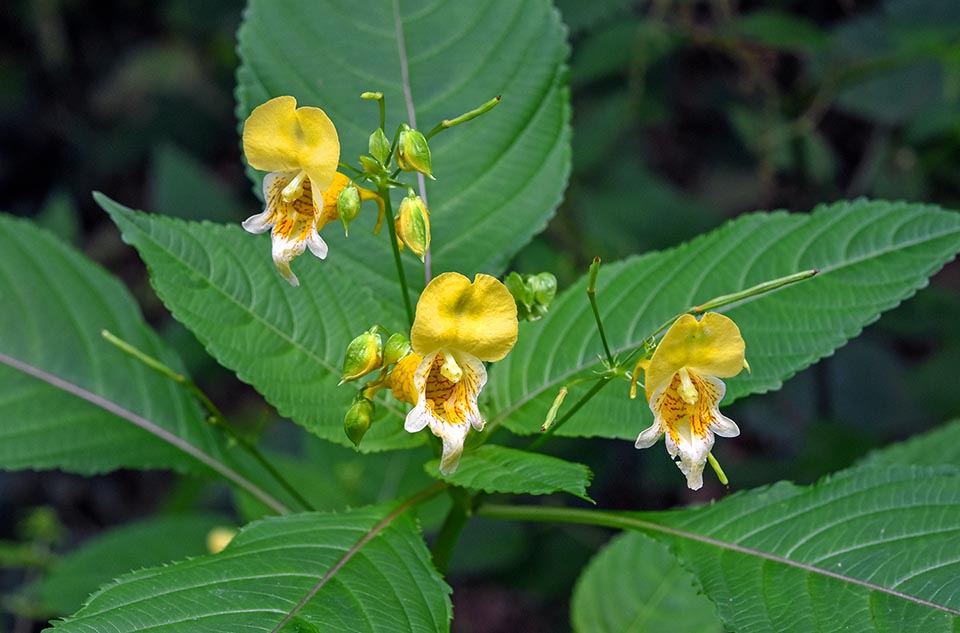
Always in Pakistan, Impatiens edgeworthii is employed in the urinary tract infections, against fever and for healing the burns © Nicholas Turland
In Pakistan they prepare decoctions of leaves of Impatiens glandulifera Royle to treat the urinary system dysfunctions, heart diseases, against baldness and miscarriages, whilst Impatiens edgeworthii Hook. f. is employed in the urinary tract infections, against fever and for the burns.
In Canada it is utilized a dough of Impatiens capensis Meerb., aerial parts, after boiling, to treat allergic dermatitis caused by the accidental contact with the poisonous plant Toxicodendron radicans (L.) Kuntze, called “Poison ivy”. It is also employed in the infection of the skin of the feet called “Athlete’s foot”, infection due by various fungi belonging to the genera Trichophyton, Epidermophyton and Microsporum. In fact, it has been scientifically confirmed that the species acts as an excellent natural fungicide.
In Congo they utilize Impatiens masisiensis De Wild. in the swellings from scabies and in skin ulcers.
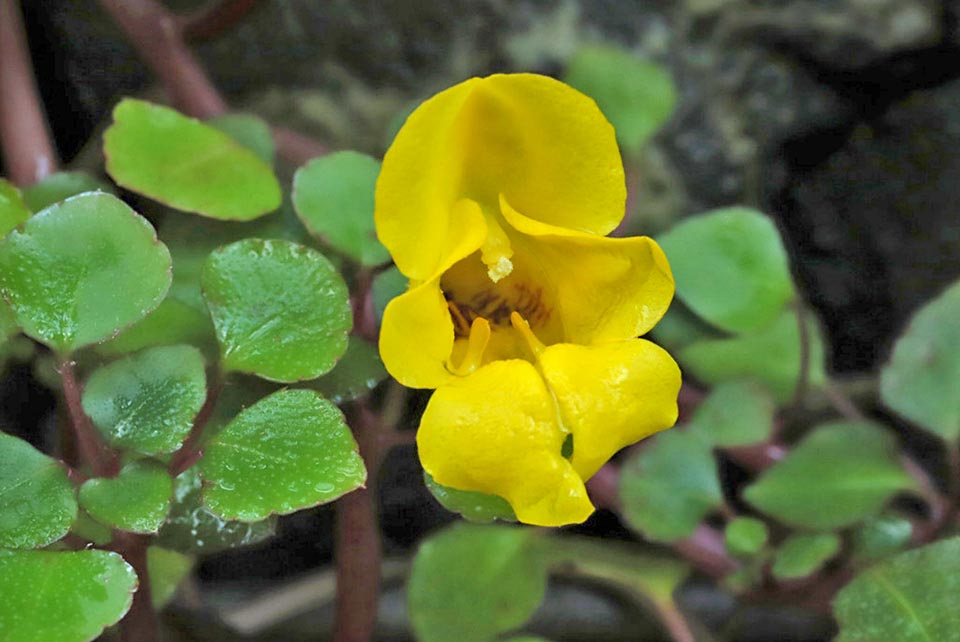
Known as Ceylon balsam or Creeping balsam, the Impatiens repens is employed in the traditional medicine of Sri Lanka. The buds and the leaves treat epilepsy © Ashitaka-f
In India the roots and the leaves of Impatiens glandulifera, crushed, are applied on the forehead, the hands and the feet due to their refreshing effect. The decoction of the leaves is utilized in case of stress and of mental tension and the flowers against the bite of snakes.
The buds and the leaves of Impatiens repens Moon ex Wight are utilized in Sri Lanka to treat epilepsy.
Impatiens balsamina L is amply utilized in the Asian countries to treat inflammations, hemorrhoids, to increase diuresis, purify the organism, for the inflamed and congested skin, to cleanse the wounds and favour healing.
In Vietnam they use to wash the hair with an extract of this plant to stimulate hair growth. Moreover, in Korea, the aerial part, when taken in high doses, is used as purgative.
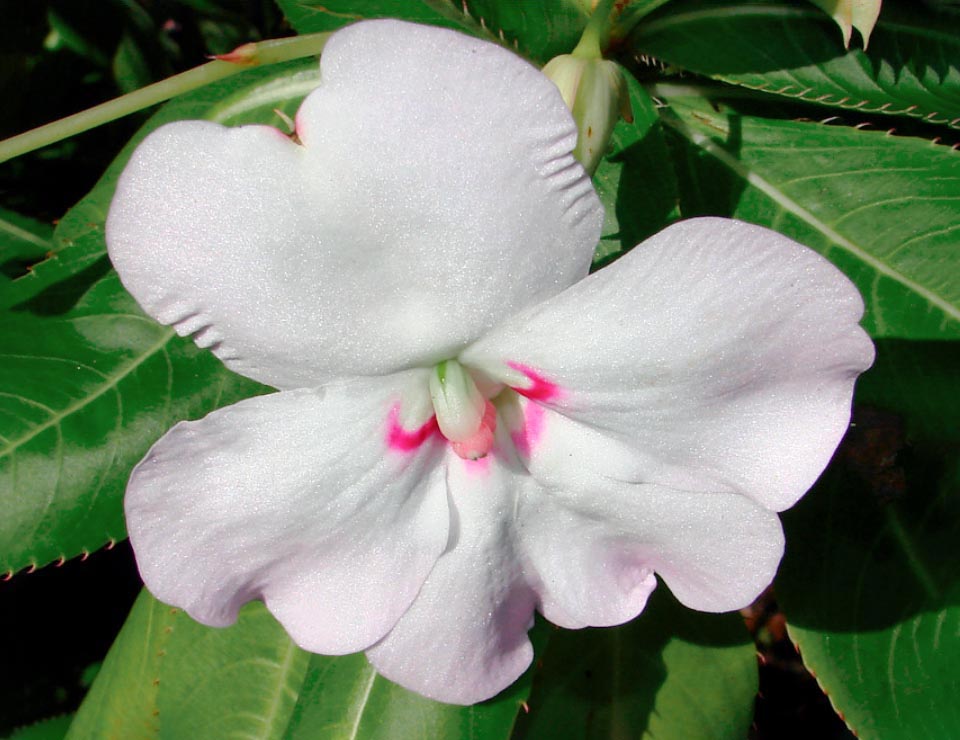
Many species of Impatiens have been introduced in Europe for their ornamental value. For instance, Impatiens sodenii, a shrubby species with showy pale pink flowers © Laurie Gray Bounsall
Recent laboratory studies have evidenced that the plant has also antitumor and histo-protective effects on pancreas, stomach, duodenum and spleen of guinea pigs subjected to tumours intentionally caused.
Various are the species of Impatiens utilized as ornamental plants. They are plants that usually prefer semi-shady positions and temperatures not under 5-10 °C. A shrubby species suitable for the gardens is Impatiens sodenii Engl. & Warb. characterized by showy pale pink flowers. In the mid-19th century it was introduced in Europe in the botanical English gardens. Nowadays it is widely in the gardens, as well as single specimens or in groups, in balconies as well as in big pots in the patios.
Impatiens balsamina, called “balsam”, “garden balsam”, rose balsam”, “touch-me-not” or “spotted snapweed” is native to India and Burma (Myanmar). Introduced in Europe during the XVI century, has been particularly appreciated by the gardeners during the Victorian decades of the XIX century.
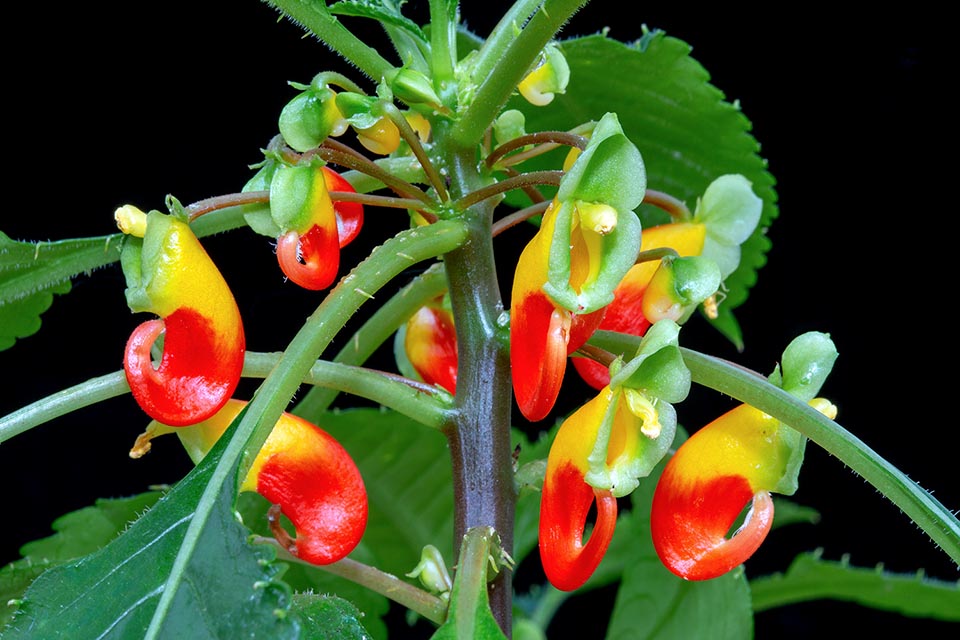
Impatiens niamniamensis, perennial species, even 2 m tall in tropical Africa, surely does not go unnoticed because of the showy flowers evoking the beak of a parrot © Giuseppe Mazza
The first plants had unattractive colours and shapes, but thanks to talented hybridizers, were created varieties and cultivars of pin, white, red, violet and intense pink flowers. Some varieties had even double flowers to resemble those of the camellias: I. balsamina ‘Camellia Flowered Mix’.
In cultivation, I. balsamina grows better in rich and loose soils with sufficient water, it blooms in the summer months whilst in the tropical areas it is blooming almost all the year round. This plant has been awarded the “Garden Merit” of the Royal Horticultural Society.
Another annual bushy species reaching the height of 60 cm is Impatiens walleriana Hook.f., native to eastern Africa. It has a splendid flowering, with the most varied colours and the leaves of intense green. It is suitable also to create flower beds. Many varieties and hybrids do exist, differing for shape, colour and size
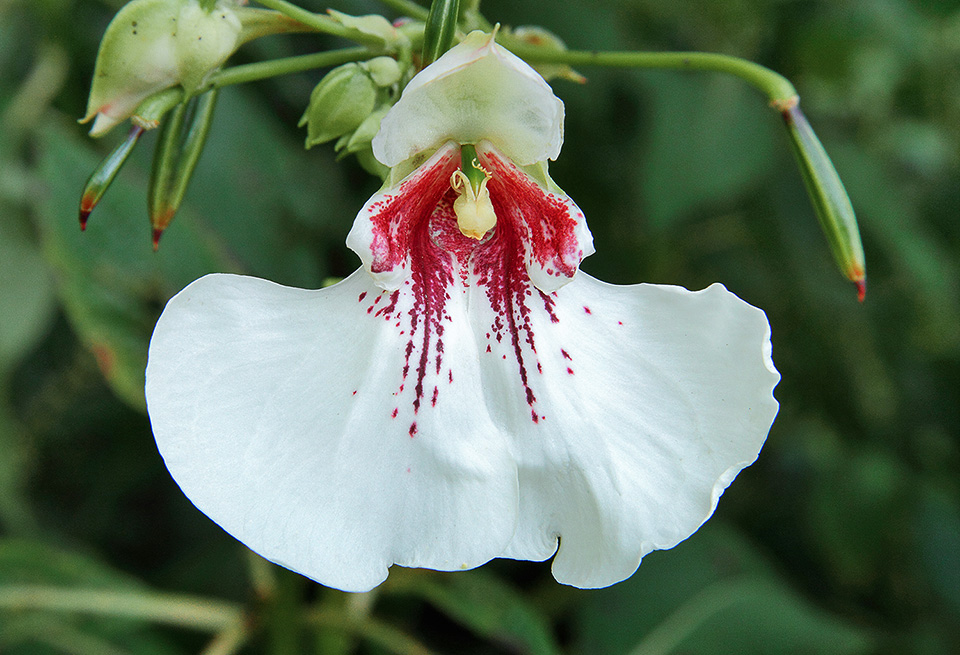
In the African rainforests, Impatiens tinctoria reaches 3 m of height. The 7-8 cm broad flowers resemble the orchids’ ones, with a scent similar to that of the Gardenias © Paul Braham
Impatiens repens is a perennial species, evergreen, with low and creeping posture. It is found in tropical rainforests of Sri Lanka, but in nature it is rare due to the destruction of its habitat. It has a rather slow growth, reaches a height of 50 cm and has small leaves, reniform, of dark green colour and reddish stems. The flowers are big and are golden-yellow. It is cultivated in the gardens as a ground cover plant, but if the temperatures are less than 10 °C, it must be protected. Also I. repens has won the award “Garden Merit” of the Royal Horticultural Society.
Impatiens niamniamensis Gilg, native to tropical Africa in the humid and shady thickets, from 350 to 2.400 metres of altitude, has very elegant flowers, resembling the beak of a parrot. In Congo the plant is called “cockatoo” or “parrot plant”. It is a perennial evergreen species, up to one metre tall (in its origin countries even two metres) with erect stem, succulent and of brown colour.
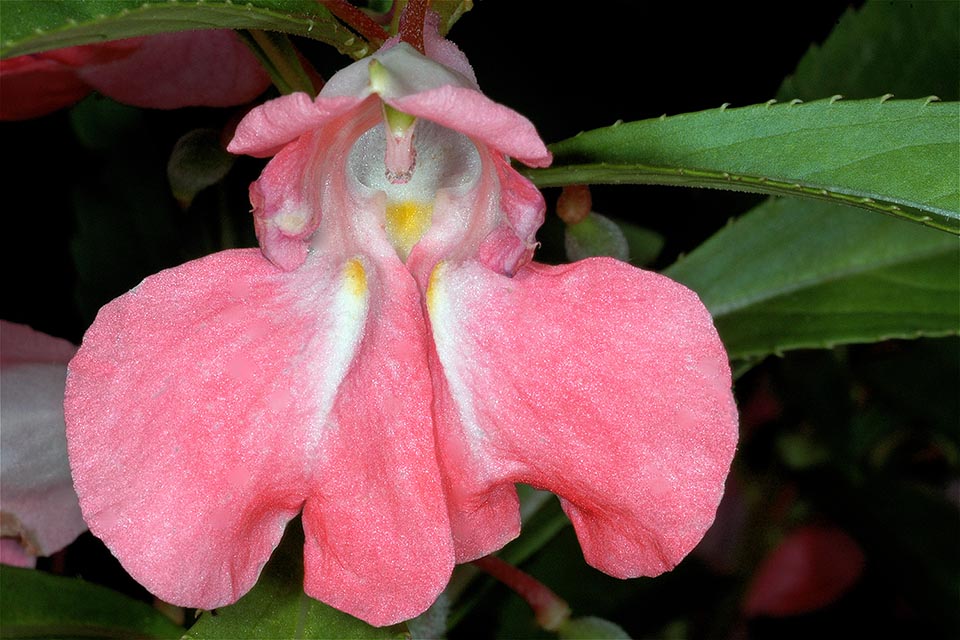
Impatiens balsamina, who has named the family, has been particularly appreciated by gardeners during the XIX century Victorian decades and has now several varieties © Robert Combes
The leaves are simple, of elliptical shape with crenate margins, spirally arranged, up to 10 cm long, of dark green colour. The flowers, up to 3,5 cm large, and with a long curved nectariferous spur, are axillary on the leaves, grouped in inflorescences of 2-6 flowers and, in the most diffused clone, usually of scarlet red and yellow colour. The fruits are explosive capsules of about 1,4-1,6 cm. The plant is widely cultivated, in temperate zones, and requires protection from temperatures under 10 °C. It multiplies by cutting or by seed. By cutting it can be rooted also in hydroponic cultivation. It has been awarded of the prize “Garden Merit” of the Royal Horticultural Society. In cultivation also exists the variety, with variegated leaves, I. niamniamensis ‘Golden Cockatoo’.
Impatiens tinctoria is a species of the African rainforests that can reach a height of 3 m. The flowers stand among the largest of the genus having a diametre of about 7-8 cm. They resemble those of the orchids and emit a scent similar to that of the Gardenias.
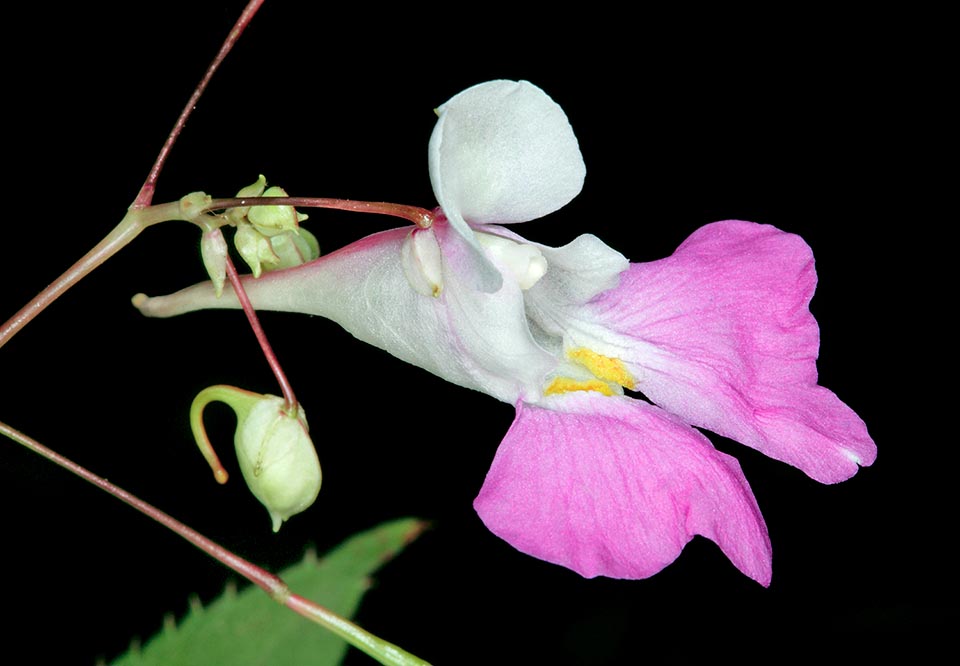
Impatiens balfourii fruit is a capsule that explodes at the least impact, throwing far away numerous seeds. Often grown as annual, can become invasive © Giuseppe Mazza
Impatiens flaccida Arn. is a species coming from the island of Ceylon and is particularly suitable for the cultivation as indoor plant. It has erect stem and violet flowers, even if there is a variety with white flowers, (I. flaccida ‘Alba’). It can be 40 cm tall.
Impatiens balfourii Hook.f. is a species coming from the Himalaya region; it is perennial, but in cultivation is an annual plant because it is very delicate in the locations with temperate climate. It has a herbaceous stem, fleshy and of reddish colour up to one metre tall. The leaves, carried by a 1-2 cm winged petiole, are oval-lanceolate with toothed margins. The flowers, arranged in inflorescences of 3-8, are of purple pink colour in the lower part and white in the upper one; the 12-18 mm long spur, is straight or slightly curved. The fruit is a capsule that explodes at the slightest impact, throwing far away the numerous seeds. This species is dangerous as it can escape the cultivation. It easily colonizes the forest’s clearings, the edges of the paths and the ruderal zones with dense populations, monospecific, that prevent the development of the autochthonous species.
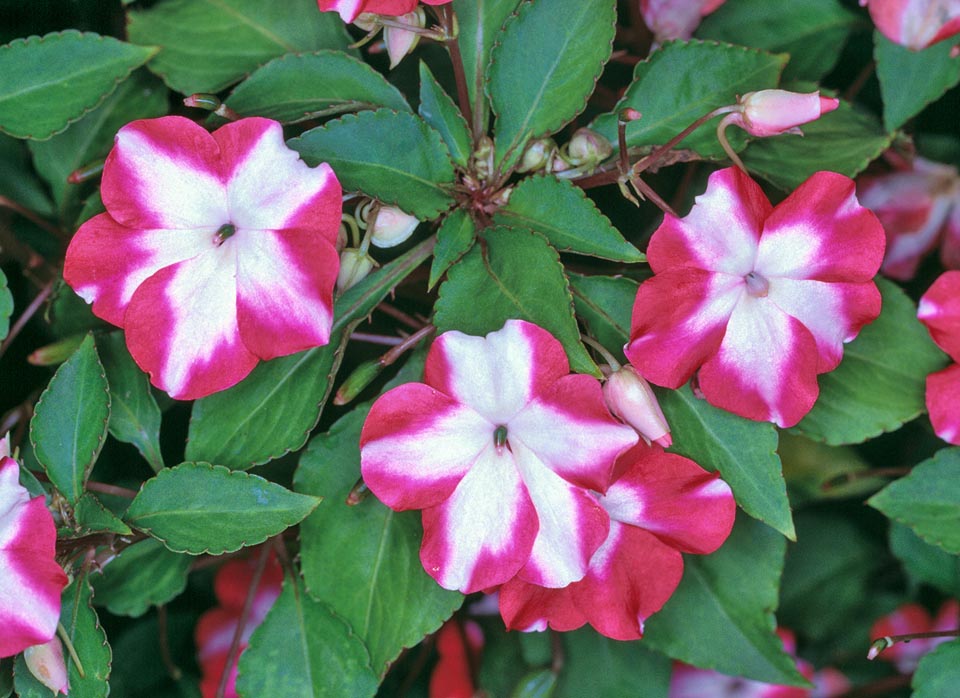
Impatiens walleriana, that well adapts to create bedflowers, is present in all the world nurseries with countless hybrids of various shapes and flowers © Giuseppe Mazza
The cultivation of the species of Impatiens and their varieties and their hybrids is fairly simple. In fact, they are rustic plants that adapt to the temperate climates and require little cares.
They can live indoors even in conditions of poor light. However, the low temperatures and the humidity favour the occurrence of fungal diseases, in particular the oidium or powdery mildew and the rust (Cronartium flaccidum (Alb. & Schwein.) G.Winter, 1880).
They can be also attached by the aphids known also as plant-aphids, if they are under stress caused by unsuitable conditions for their growth.
Genera: Hydrocera, Impatiens.
→ To appreciate the biodiversity within the BALSAMINACEAE family please click here.
